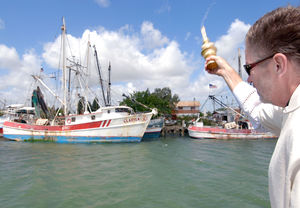With local crews preparing boats for the reopening of the Texas shrimp season in about a week, the Brownsville-Port Isabel shrimp fleet once again received a much-needed blessing Wednesday courtesy of Father Mark Watters. In the shade of a large, open-air shed at Zimco Marine on the Brownsville shrimp basin, diesel exhaust fumes from the idling trawler “Miss Opal” borne through the crowd by a stiff south wind, Watters led prayers against the industry’s tough times and the negative emotions they produce, and delivered a rousing sermon in the manner of a coach’s pre-game pep talk. “Use the fear and turn it into fuel to praise God and change your life forever,” he insisted.
Watters also prayed for a bountiful harvest and safety for crew members before boarding the cheerfully festooned Miss Opal for a circuit around the basin’s white-capped waters to bless individual vessels and crews.
The crowd of several dozen included Brownsville Navigation District Commissioner Ralph Cowen and Chairman John Wood, Texas Department of Agriculture assistant commissioner for Water and Rural Affairs Dan Hunter, and Bobby Champion Jr., Texas Coastal Marketing coordinator for the agricultural department. Gary Graham, a professor and marine fisheries specialist with Sea Grant Texas at Texas A&M University , was also in attendance, and said that excessive freshwater in the bays due to heavy spring rains has hindered development of the brown shrimp that the local fleet largely depends on. Not just the size but also the volume of shrimp appears to have been affected, he said. “I’m concerned with the overall number of shrimp that are going to be produced from our Texas base this year because of all the freshwater,” Graham said.
With the end of the rains and salinity levels in the bays returning to normal, late crops are coming on farther up the coast, though the size of the shrimp is very small, he said. Fortunately for shrimpers, the animals are “highly migratory,” Graham said.
“We hope that Louisiana has a good crop of brown shrimp, because we can go fish off Louisiana as well,” he said. “I’ve spent more time in a boat off Louisiana than I have from Texas .” There’s also the chance for a good white shrimp harvest. White shrimp, which benefit from large amounts of freshwater, are a near-shore variety not heavily fished by the local fleet, Graham said. “Some of the guys do it, but mainly these boats are geared up for the deepwater brown shrimp,” he said. “If you go up to Port Arthur , that fleet there, 90 percent of them fish white shrimp.” Even if the brown shrimp are on the small side small this season, closing the season for two months each year has generally been successful in producing larger individual shrimp for harvest, Graham said. “That’s worked well for us for many, many years,” he said. “Right now with the pricing situation the way it is, there’s a huge price differential between a large shrimp and a medium or small shrimp. Big ones is what we want.” Since shrimp is an annual crop, a dismal year can potentially be followed by a record-breaker, Graham said. “That aspect of the annual crop is so important,” he said. “The industry should be there as long as we can get recognition for our Texas shrimp.”
Andrea Hance , executive director of the Texas Shrimp Association, said Graham’s forecast of smaller-than-normal shrimp is “not what we want to hear.” “We certainly hope that the prices come up just a little bit,” she said. “Right now they’re really low. The only shrimp that we’re actually making money on are the colossal-sized shrimp, because (foreign) farms can’t grow their shrimp to be that size. If we’re stuck harvesting the smaller shrimp then our prices are going to be suppressed.” “Colossal” isn’t a precise term, but generally indicates fewer than 12 or 15 shrimp per pound, Hance said. “We’re just going to have to hope and pray we come out ahead,” she said. “A good year this year is if we pay back what we borrowed.”





